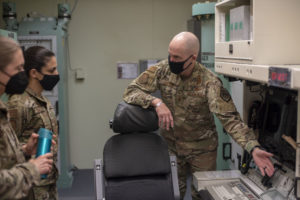Ukraine’s conduct is a warning to U.S. leaders that a technically inferior adversary can impose surprisingly sharp costs.
Russia’s awful military performance in Ukraine has been the greatest surprise to emerge from President Vladimir Putin’s unprovoked invasion, confounding military analysts who had observed tactical and technological improvements in the Russian military in preceding years.
By now it’s clear that Putin’s ambition to capture the port of Odesa and the capital of Kyiv in western Ukraine is almost certainly unrealizable, forcing him to drastically downsize his objectives while disingenuously claiming that had been the real intent all along.
But there’s a flip side to this story: The Ukrainian military has also defied expectations. In the case of the Ukrainian armed forces, they’ve performed well beyond what was anticipated despite a profound imbalance in military capabilities, particularly in air and naval power and long-distance missiles.
The secret to Ukraine’s success rests first of all on its mindset — one Russia itself has strengthened — backed up by dynamic military strategies that have exploited the weaknesses of a powerful, overconfident adversary.
For starters, the Ukrainians came into the war with a drastically greater will to fight in defense of their homes and way of life. As Napoleon once put it in explaining factors behind military success, “The moral is to the physical as three is to one.” Accordingly, Ukrainian units are not panicking and evaporating under intense pressure, instead holding out for weeks in besieged cities like Chernihiv and Mariupol. And when facing setbacks, Kyiv’s troops are aggressively and rapidly counterattacking, often checking or reversing Russian gains.
This spirit has been inflamed by Russia’s brazenly unprovoked invasion. Putin’s onslaught temporarily bridged long-standing divisions between Ukrainian and Russian speakers within Ukraine, as well as between political rivals, creating a unified, coordinated force for confronting the invaders. Even occupied cities with predominantly Russian-speaking populations — which have traditionally been more favorably inclined toward Russia — are actively resisting through civil disobedience and protests.
By comparison, Putin seems to have poorly communicated his intentions and objectives to ordinary Russian soldiers, which didn’t instill a strong commitment to the fight among the rank and file. He spent months ridiculing suggestions that he was preparing for war in Ukraine, claiming deployments around the country were simply military exercises. Now some soldiers appear quick to abandon vehicles or surrender rather than die for a war they’re simply not sold on.
The Ukrainian mental edge was already evident in 2014 and 2015, when Putin started aiding pro-Russian separatists in eastern Ukraine and Ukrainian soldiers resisted so stubbornly they were nicknamed “cyborgs.” By 2021, Ukraine’s military had years of combat experience and were demonstrably stronger thanks to new weapons, military aid and tactics, which is part of why I wasn’t confident that those who doubted how the Ukrainian armed forces would perform in this contest were correct.
Still, I joined the skeptics in thinking Ukraine’s air force could not long survive vastly superior Russian air power in a full-scale conflict or that ground forces outside of cities could long survive the lack of air cover. But with limited means — just around 100 combat aircraft, less than a tenth of Russia’s more modern force — Ukrainian fighter pilots and ground-based air defenses still contest the airspace over Ukraine, inflicting losses and compelling Russia to use its warplanes less effectively.
One shouldn’t exaggerate: Russia is calculated to be flying a few hundred combat missions daily; Ukraine is averaging less than a dozen, and its air force has suffered important losses. But Russia’s warplanes are relying more and more on inaccurate bombs dropped from high altitude and expensive, limited-supply cruise missiles. When they don’t, Russian jets are getting shot down by short-range missiles, including portable weapons sent by NATO.
To overcome these huge Russian advantages in the sky, Ukraine has waged a guerilla air war of sorts. It apparently dispersed combat aircraft to secondary air bases, or possibly even highways, just before the invasion to avoid their being wiped out on the ground by Russian missile strikes.
Its ground-based air defense batteries, meanwhile, are only briefly activating their radars to ambush Russian warplanes — often aided by a World War II-style network of spotters on the ground — to be harder to track. Kyiv is also reaping dividends from the unmanned aircraft it wisely invested in, picking off Russian fuel transports, command posts and air defense vehicles. Russia’s military is struggling to shoot down these small, slow-flying aircraft, perhaps fearing their powerful jammers could harm communications with their own planes.
Ukraine’s military has arguably managed to blend its inherited Soviet-era legacies — abundant artillery and armored vehicles, greater reliance on ground-based air defenses than fighter aircraft — with selected Western advantages such as the practice of empowering noncommissioned and junior officers on the ground to take initiative, and using intelligence to stage precision attacks. These have killed seven Russian generals, according to Ukraine, and devastated a Russian helicopter base.
Notably, stealthy teams of Ukrainian infantry have ably used thousands of portable long-distance anti-tank weapons supplied by the West, as well as manufactured by Ukraine itself, to disable hundreds or more Russian armored vehicles and supply trucks in ambushes and hit-and-run raids. There’s often an instinctive desire to use heavy forces to fight heavy forces, when sometimes well-armed soldiers on foot can do the job better because they’re less likely to be spotted. Ukraine showed foresight in focusing on these types of weapons requests from allies.
Above all, Ukrainian forces have fought asymmetrically: Rather than seeking to stop Russia’s superior might on the border, the Ukrainian leadership has used Ukraine’s sheer geographic expanse as a strength in itself, recognizing that major cities can serve as deadly tar pits for attacking forces. As a result, it’s yielded indefensible open ground while stoutly holding on to densely urbanized areas. Russian troops, therefore, are left with stretched-out and vulnerable lines of supply, with large forces dedicated to surrounding cities they can’t capture to protect these supply lines. To help offset the mismatch further, Ukraine has been highly nimble at distributing imagery of battlefield successes and humanitarian distress to rally Western support.
Of course, it would be wrong to characterize Ukraine’s war effort as flawless. Ukrainian President Volodymyr Zelenskyy, for instance, failed to fully mobilize until after Russia initiated hostilities. The political rationale behind this — avoiding giving Putin an excuse for an attack, as well as prematurely damaging the Ukrainian economy — might have been the wrong calculation, since it helped Russian troops rapidly seize three medium-sized cities in southern Ukraine at the onset.
Furthermore, dozens of Ukrainian troops have been killed by Russian missile attacks while sleeping in barracks. Their quarters should have been dispersed. And the coming weeks will test Kyiv’s decision not to pull back veteran brigades from the eastern Donbas region, where they remain at risk of being surrounded by encroaching Russian forces.
Regardless, the Ukrainian military’s conduct should give NATO plenty to learn from. If nothing else, it illustrates to U.S. leaders how a technically inferior adversary can impose surprisingly sharp costs on a seemingly overwhelming foe. Since Vietnam, the U.S. military hasn’t fought a major war with a state-level adversary with highly motivated soldiers and capable military leadership. Ukraine is now providing an object lesson in how and why that’s a dangerous combination to underestimate.
Sébastien Roblin writes about the technical and historical aspects of international security and conflict for The National Interest, War is Boring and other publications. He tweets @sebastienroblin.




